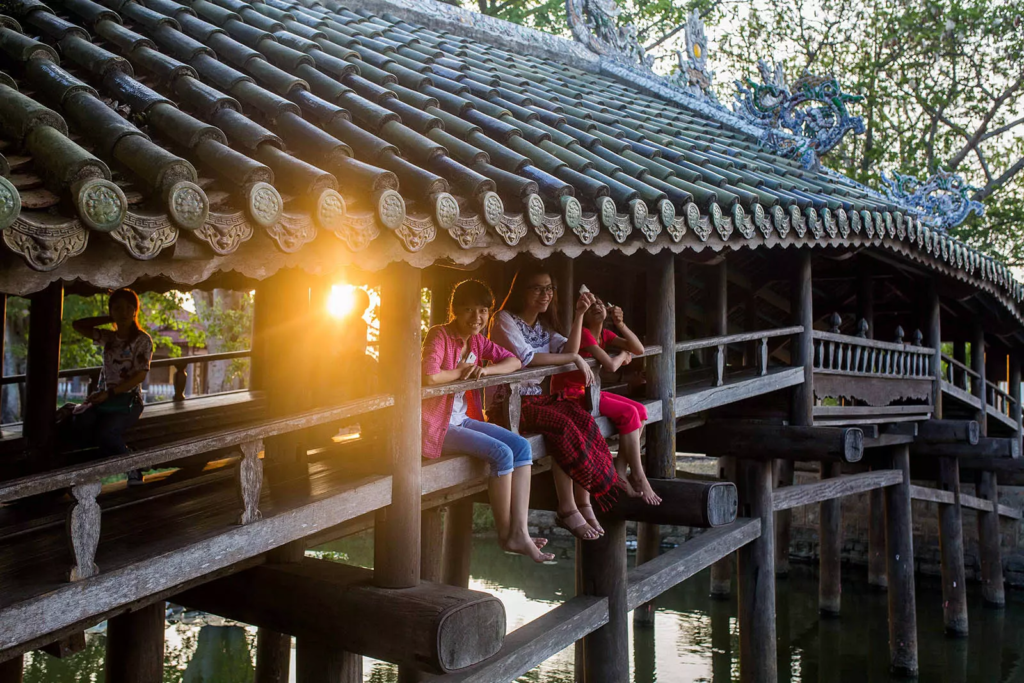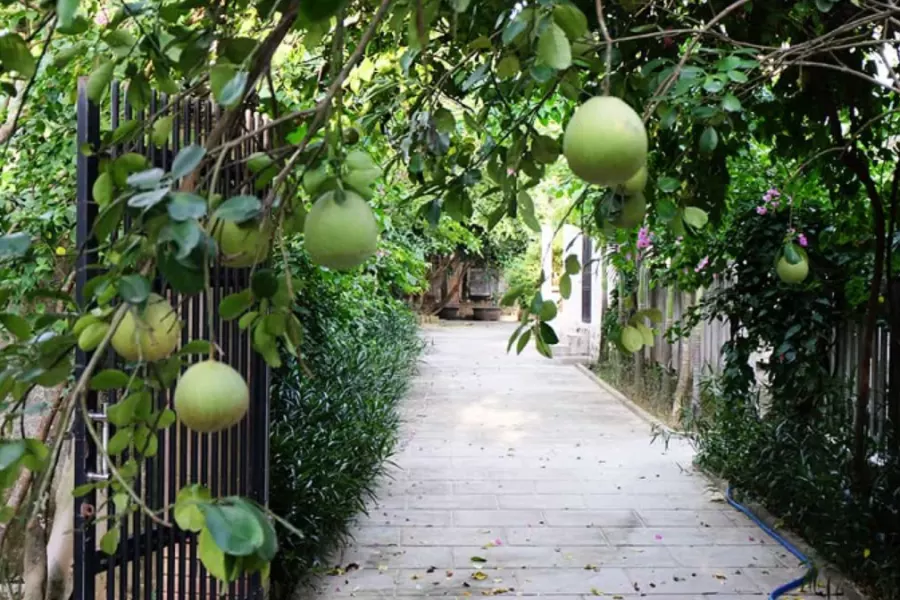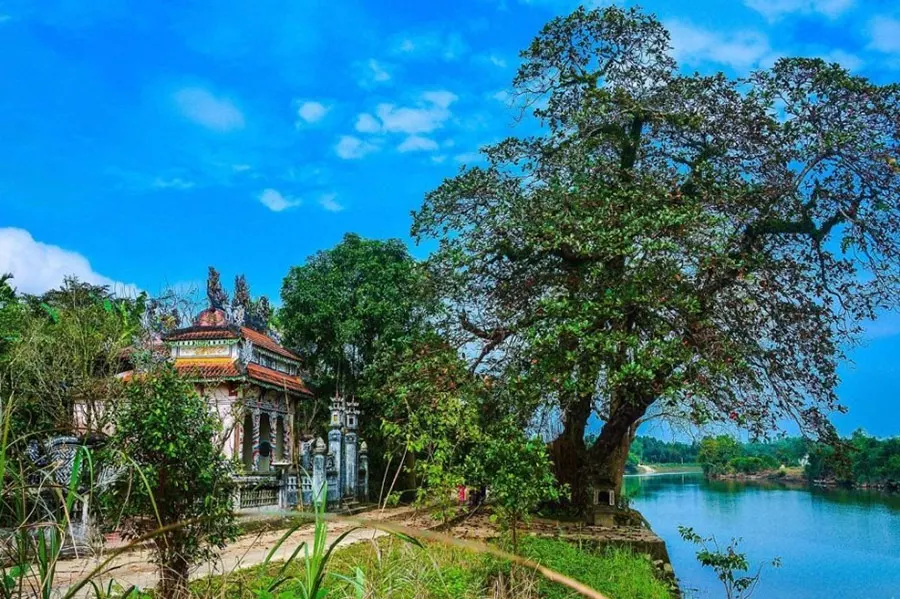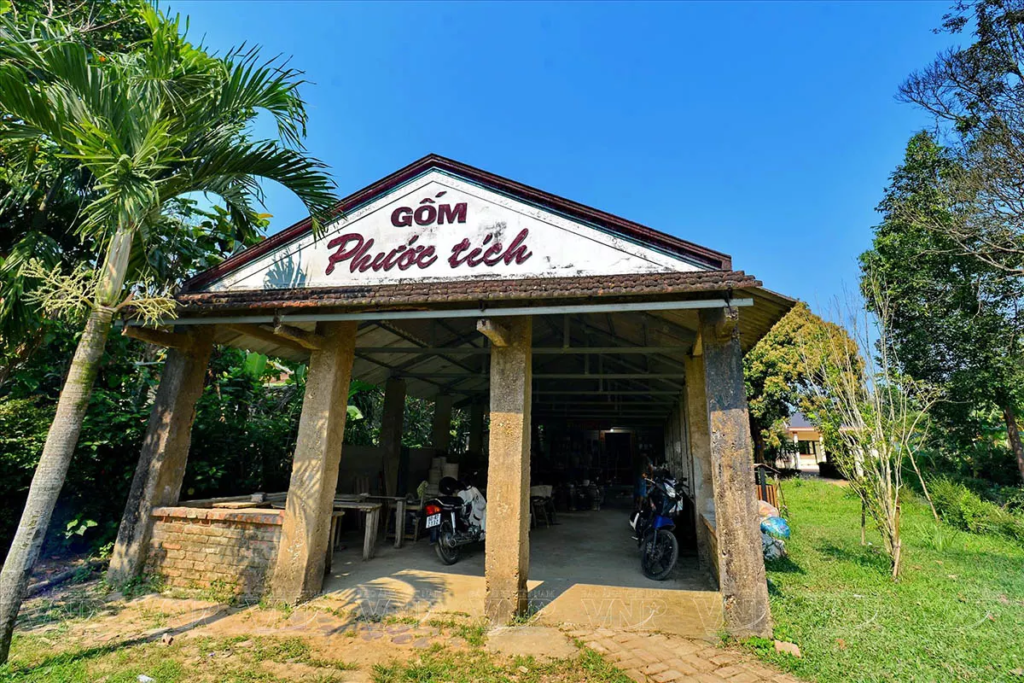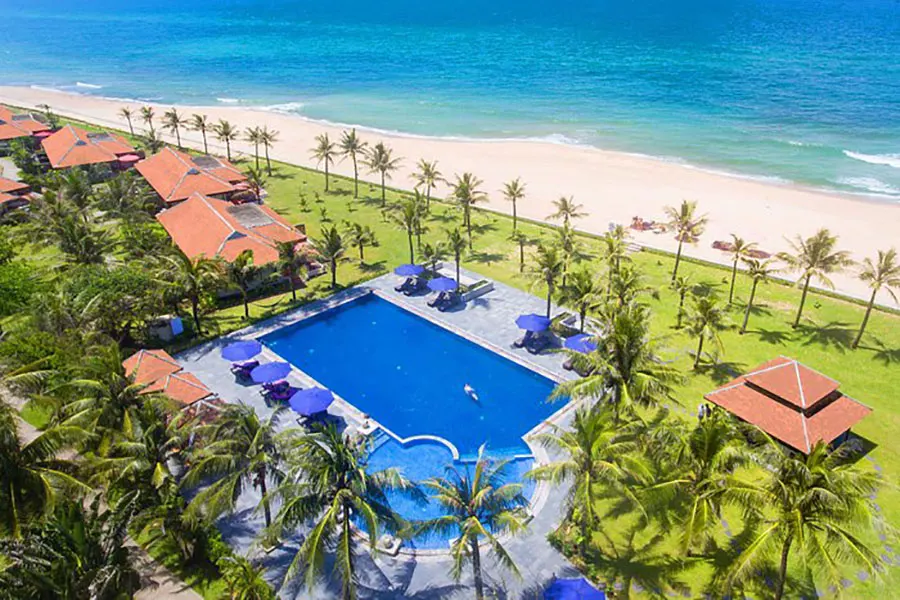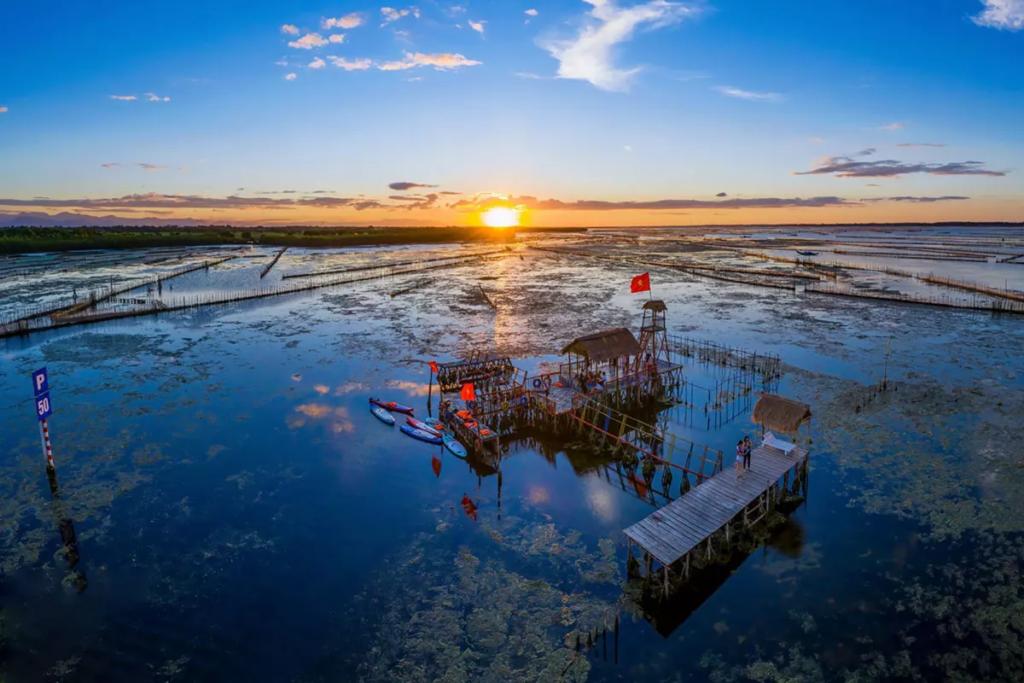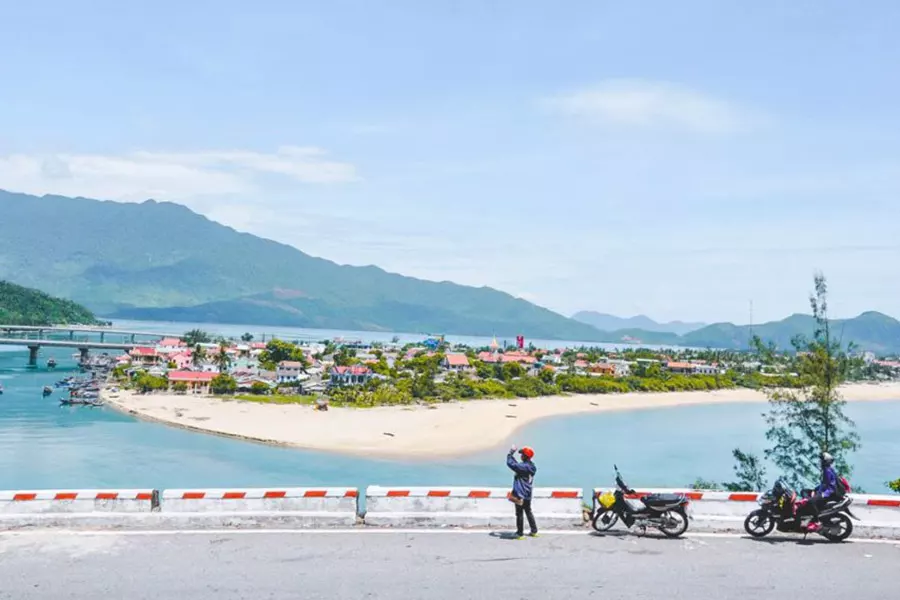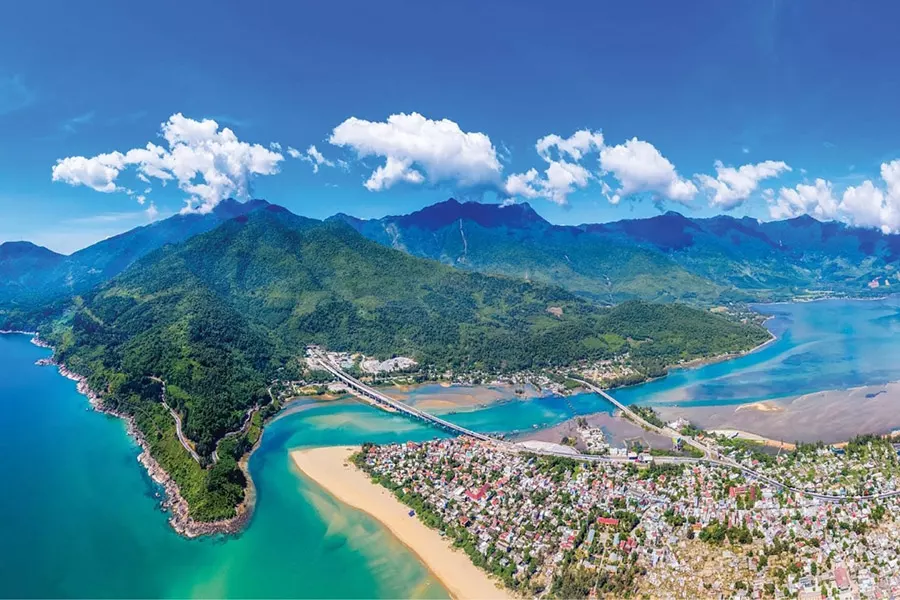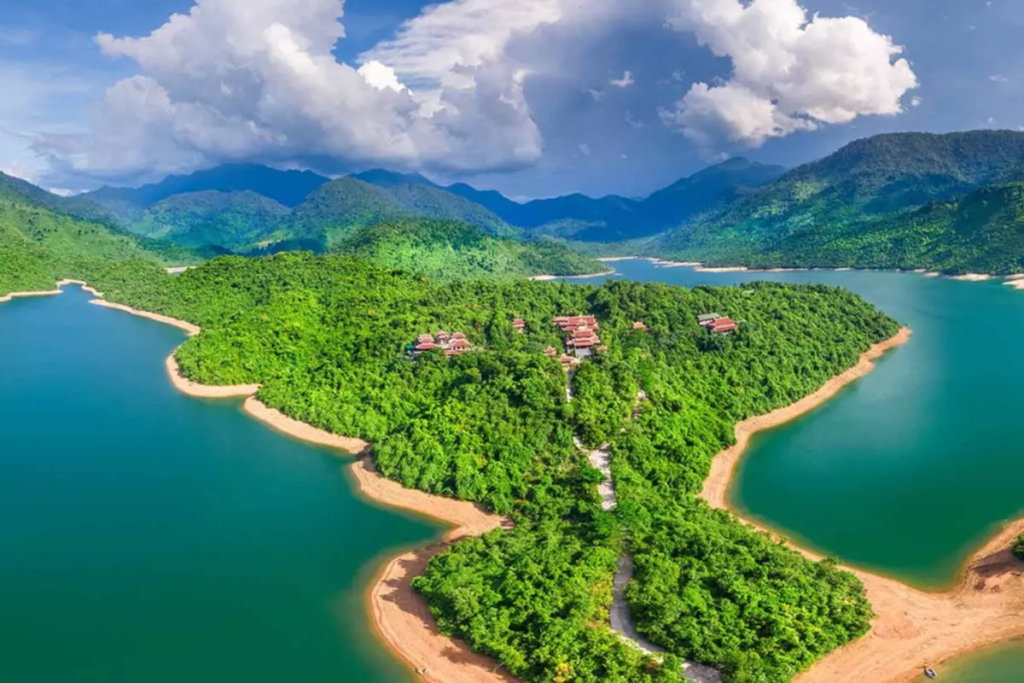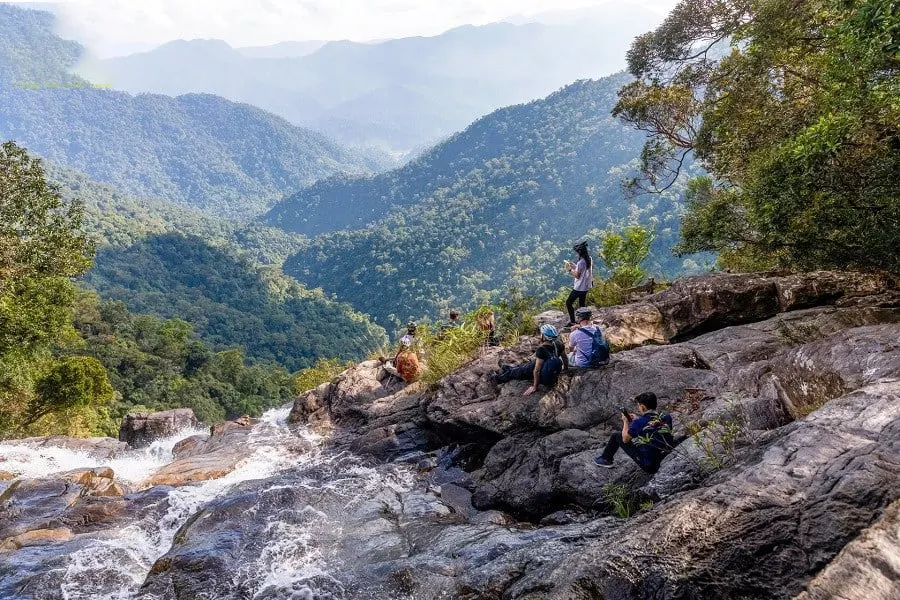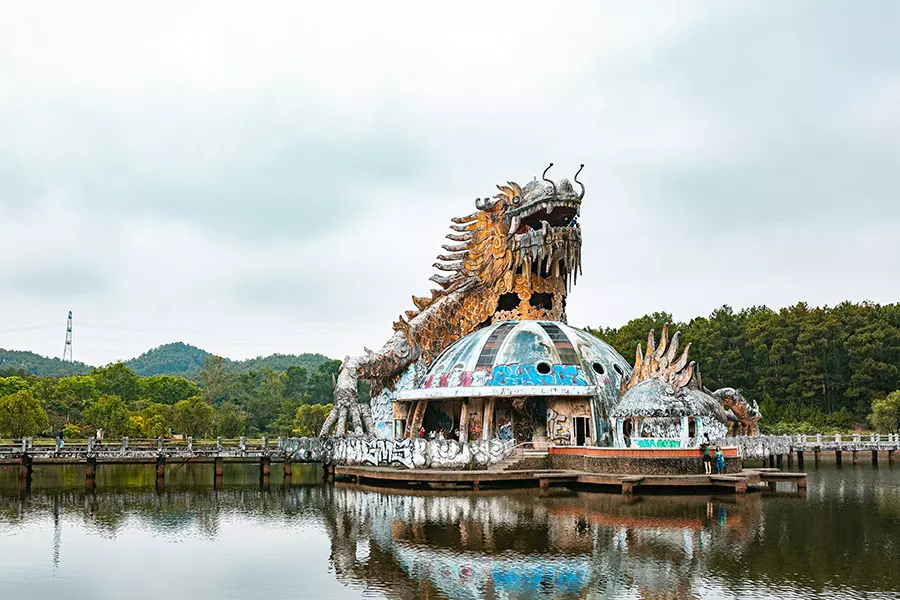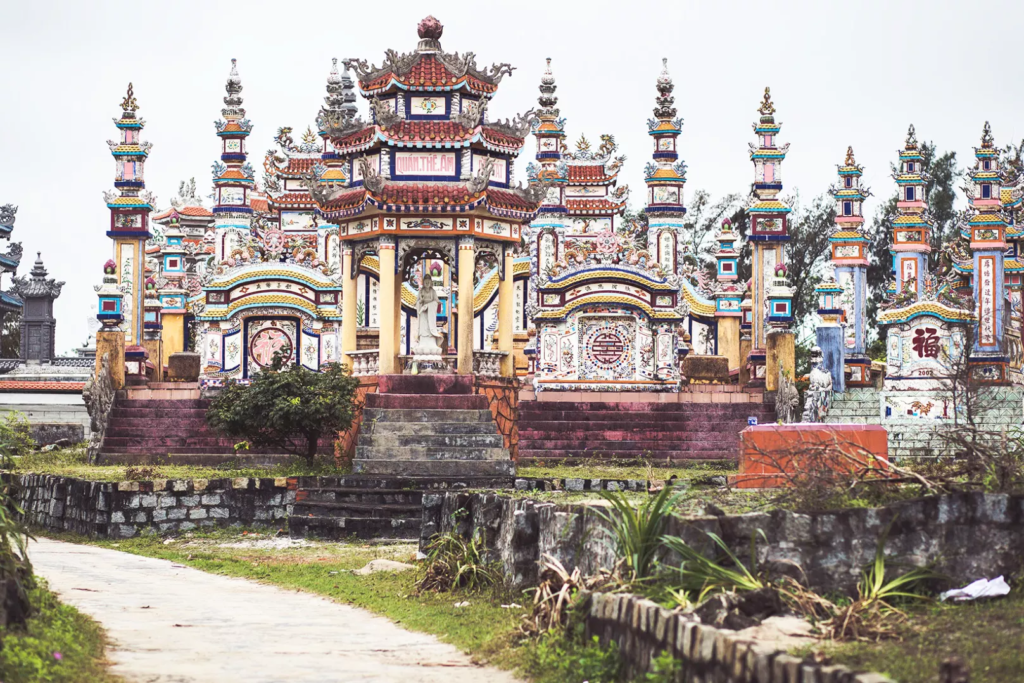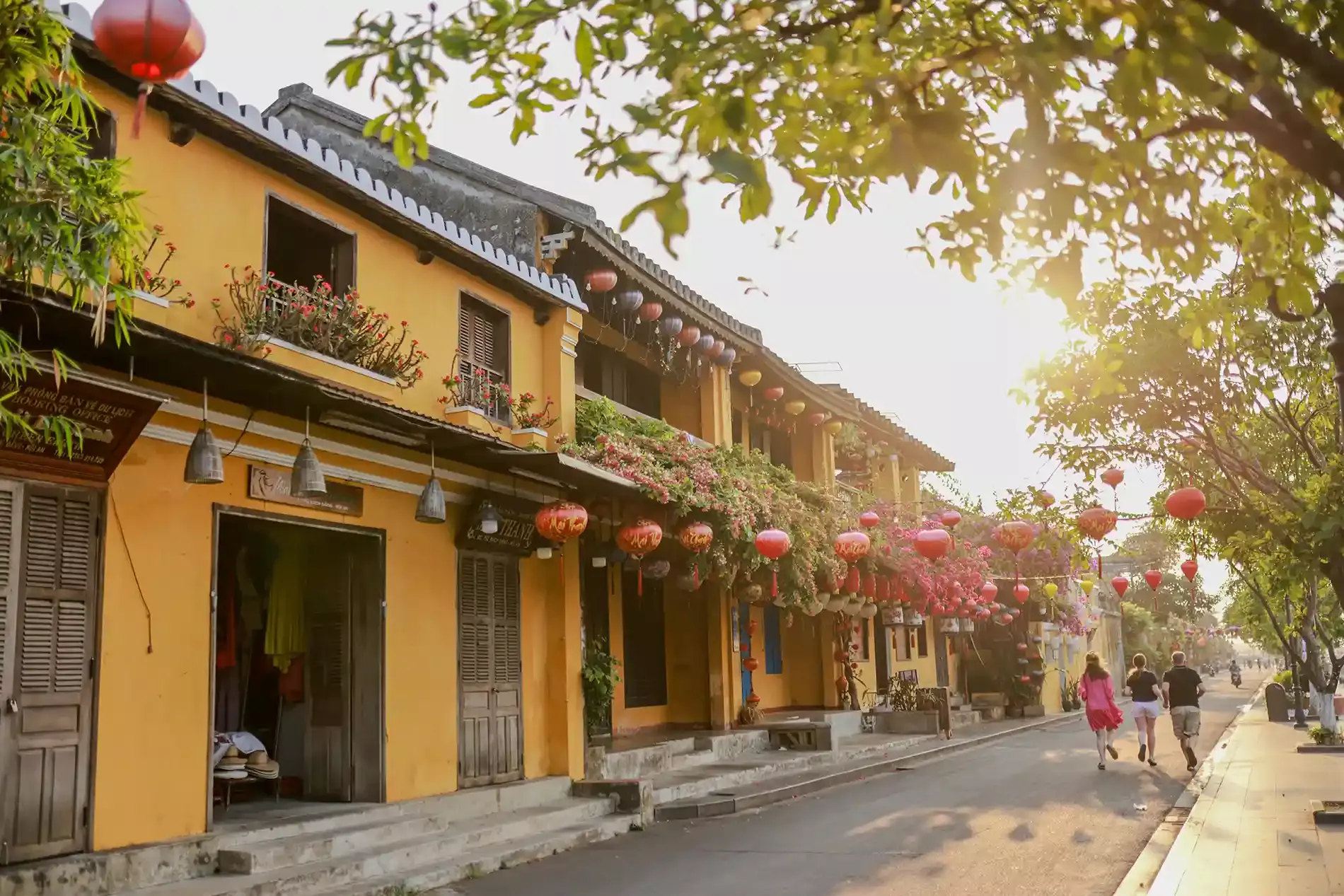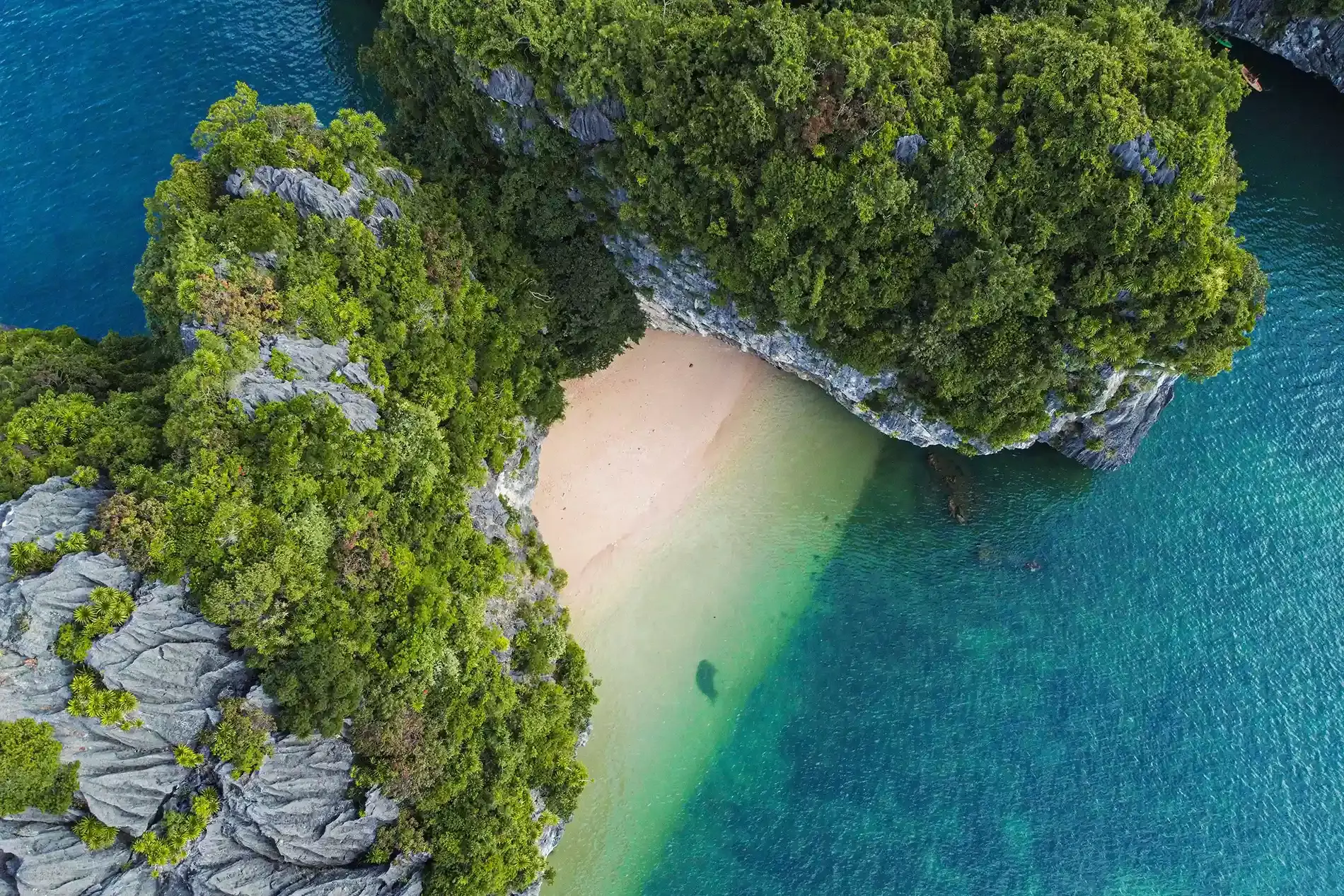
What to see around Hue ? The most beautiful places to discover
Located in central Vietnam, the city of Hue is surrounded by picturesque landscapes and fascinating, exotic sites. The areas around Hue offer a variety of destinations to explore, ranging from peaceful beaches to lush green hills, as well as national parks and traditional villages. This article provides a detailed list of the main places to visit around Hue, along with descriptions to help you plan your excursions.
Table des matières de l'article
Cultural and historical visits
Thanh Toan covered bridge
The Thanh Toan covered bridge, located about 8 kilometers east of Hue, is a masterpiece of traditional Vietnamese architecture. Built in the 18th century during the Nguyen dynasty, this wooden bridge is one of the few remaining examples of covered bridges in Vietnam. It was constructed at the initiative of Madam Tran Thi Dao, a local benefactor, to connect the two banks of the canal and facilitate villagers’ movement. In recognition of her contribution, the emperor granted her honorary titles.
The bridge, 17 meters long and 4 meters wide, features a tiled roof that shelters passersby from the weather. Its finely crafted decorative carvings, massive wooden pillars, and ingenious structures showcase the craftsmanship of the era. Inside, wooden benches are arranged, offering a place for locals to rest or chat in peace. Today, the Thanh Toan covered bridge is a designated national historical monument and continues to embody the charm of a bygone era, symbolizing the harmony between humans and nature.
Thanh Toan covered bridge. Photo : Mathieu Arnaudet
Thanh Toan bridge is set in a picturesque rural environment, surrounded by rice fields, peaceful canals, and small traditional villages. It’s an ideal spot for a leisurely afternoon stroll through the Vietnamese countryside, far from the bustle of the city. As you walk across the bridge, you can enjoy the bucolic landscapes stretching on either side of the canal. The serene setting offers a truly calming atmosphere, providing an authentic immersion into Vietnamese rural life.
Thuy Bieu village
Thuy Bieu Village, located about 7 kilometers west of Hue, is a true haven of peace, offering visitors an authentic glimpse of rural Vietnamese life. Known for its traditional garden houses, called “nha vuon,” and its lush Thanh Tra pomelo orchards, this small village is a living example of Hue’s architectural and cultural heritage. As you wander through the shaded lanes of Thuy Bieu, you’ll discover ancient houses surrounded by verdant gardens where pomelos, guavas, and other tropical fruits grow, symbols of the region’s prosperity.
Thuy Bieu is distinguished by its peaceful atmosphere, far from the hustle and bustle of the city. Nestled along the Perfume River, the village is an ideal place to immerse yourself in traditional Vietnamese culture while enjoying the natural beauty surrounding Hue. The warm and welcoming locals uphold ancestral customs and are happy to share their way of life with curious visitors.
The famous pomelos of Thuy Bieu village
One of the best ways to explore the village is by taking a bike ride along the paths that wind between the orchards and garden houses. These rides not only allow you to enjoy the tranquility and beauty of the landscape, but also to meet the locals, who are often delighted to share their expertise and traditions.
One of the highlights of the visit is undoubtedly tasting fresh fruits directly in the pomelo orchards. The Thanh Tra pomelo, a local specialty, is renowned for its sweet taste and delicate fragrance. Depending on the season, you may also have the chance to try other tropical fruits harvested from the village’s orchards.
For those who want to immerse themselves further in the local culture, Thuy Bieu also offers Vietnamese cooking classes.
Hon Chen temple
Perched on a hill overlooking the Perfume River, Hon Chen Temple is one of the most revered religious sites in the Hue region. Built in the 17th century, this ancient temple is dedicated to the goddess Po Nagar, also known as Thien Y A Na, a deity worshiped by both the Cham and Vietnamese communities for her protection and benevolence. This sacred place is not only a spiritual center but also a unique architectural testament, blending Cham and Vietnamese influences in its structures. Visitors are greeted by colorful tiled roofs, detailed carvings, and altars adorned with floral offerings, creating an atmosphere that is both mystical and calming.
Deeply rooted in the spiritual history of the region, the temple continues to attract numerous worshippers who come to pray for health, prosperity, and protection. For the people of Hue, Hon Chen Temple is more than just a place of worship; it is a symbol of the harmonious fusion of local traditions and Vietnam’s rich cultural heritage. Set in a beautiful natural environment, surrounded by lush green hills and offering stunning views of the river, the temple is also a place of tranquility and contemplation for those seeking an immersive spiritual experience.
Hon Chen temple
Hon Chen Temple is particularly known for its religious ceremonies and festivals, the most famous of which is the Hon Chen Festival, held twice a year, in the spring and autumn, according to the lunar calendar. These celebrations bring together thousands of worshippers and visitors to honor the goddess Po Nagar through traditional rituals, prayers, and offerings. The festive and sacred atmosphere during these events makes it an ideal time to discover local religious practices and immerse oneself in Vietnamese spiritual culture.
One of the most iconic moments of the festival is the boat procession on the Perfume River, where dozens of richly decorated boats float down the river, symbolizing the journey of souls and prayers to the spiritual world. The boats are adorned with colorful banners, lanterns, and offerings, creating a striking visual spectacle, especially at dusk when the lanterns’ lights reflect on the calm waters of the river. This water procession is a highlight of the festival, with religious chants filling the air, fostering a profound sense of communion between participants and the surrounding nature.
Phuoc Tich village
Located about 40 kilometers north of Hue, Phuoc Tich Village is one of the oldest pottery villages in Vietnam, renowned for its traditional craftsmanship that has endured through the centuries. Founded in the 15th century during the Le dynasty, this picturesque village has preserved its unique heritage, making Phuoc Tich a true cultural treasure. Recognized as a national heritage site, Phuoc Tich is not only a living testament to Vietnamese pottery art but also a remarkable example of traditional rural Vietnamese architecture.
Surrounded by the Ô Lâu River, the village is famous for its terracotta pottery, which was once highly sought after across the country for its quality and durability. Phuoc Tich’s potters produce a wide variety of items, ranging from kitchen utensils and religious decorations to vases and art objects. The artisanal skills have been passed down from generation to generation, with many craftsmen continuing to uphold these ancient techniques with care and passion.
But Phuoc Tich is not just about pottery; it is also a village steeped in old-world charm, with its century-old wooden houses, lush gardens, and peaceful temples. Walking through its shaded lanes allows visitors to experience a serene atmosphere, far from the hustle and bustle of the city, where time seems to have stood still.
Entrance of Phuoc Tich village, along the river, Hue
A visit to Phuoc Tich would not be complete without an immersion in the art of pottery. Visitors have the opportunity to take part in pottery workshops, guided by local artisans who share traditional crafting techniques. You’ll learn how to work with clay, shape objects, and understand the various stages of production, from molding to firing. These workshops offer a unique chance to create your own handcrafted souvenirs while discovering the secrets of an art that has been passed down for centuries.
Entrance to a potery workshop, Phuoc Tich village
Nature escapes
Thuan An beach
Located about 15 kilometers from the center of Hue, Thuan An Beach is a true oasis of tranquility for sea and nature lovers. With its fine golden sand and clear, soothing waters, it offers an idyllic setting for a relaxing day away from the hustle and bustle of the city. The beach stretches for several kilometers, allowing visitors to find relatively quiet spots even during the busiest times. Although popular among the locals of Hue, Thuan An retains an authentic and unspoiled charm, far from the overly touristy beaches.
In addition to its inviting waters for swimming, the beach is also known for its delicious seafood. Visitors can enjoy freshly caught local dishes at the seaside restaurants, where the atmosphere is friendly and welcoming. The stalls are filled with local specialties such as shrimp, squid, and grilled fish, which can be savored while taking in the ocean view.
View over Lapochine resort, Thuan An beach
When visiting Thuan An, don’t miss the Thai Duong temple, dedicated to the local deity who protects fishermen. This sacred and serene site is an excellent stop to learn more about local culture and beliefs. Located just a few minutes’ walk from the beach, it also offers a beautiful view of the surrounding area.
Tam Giang lagoon
Located about 30 kilometers north of Hue, Tam Giang Lagoon is the largest brackish water lagoon in Vietnam, stretching approximately 70 kilometers along the coast. This vast body of water is a true natural gem, where the meeting of freshwater and seawater creates a unique ecosystem rich in biodiversity. Home to a wide variety of fish, mollusks, crustaceans, and migratory birds, the lagoon plays a crucial role in the economic and cultural life of local communities, primarily fishermen and farmers.
Tam Giang lagoon
In addition to its ecological significance, Tam Giang Lagoon offers breathtaking landscapes, with its vast stretches of shimmering water bordered by traditional villages and wetlands. It is a place of peace and serenity, far from the hustle and bustle of the cities, where life seems to follow the natural rhythm of the tides and seasons. Visitors will discover an authentic side of rural Vietnam, where ancient traditions and nature blend harmoniously.
Lang Co fishing village
Located about 70 kilometers south of Hue, the fishing village of Lang Co is a popular destination known for its idyllic natural setting and peaceful atmosphere. Nestled between the lush mountains of the Annamite Range and the East Sea, this picturesque village offers the perfect blend of sea and nature, with a pristine white sandy beach on one side and a tranquil lagoon on the other. This little slice of paradise is not only an ideal spot for relaxation but also a place where the daily lives of fishermen provide an authentic glimpse into Vietnam’s coastal culture.
Lang Co remains relatively untouched by mass tourism, making it a haven for travelers seeking tranquility and spectacular natural landscapes. With its lush mountains as a backdrop, crystal-clear waters, and traditional fishing huts, the village exudes a calming atmosphere where the pace of life slows down, allowing visitors to fully appreciate the natural beauty of the area. The vast, serene Lang Co Lagoon adds a unique dimension to the coastal scenery, offering soft reflections and stunning sunsets.
Road passing in front Lang Co village
Lang Co village is the perfect spot for those looking to relax on the beach while being surrounded by stunning landscapes. Lang Co Beach, with its fine white sand and crystal-clear blue waters, is ideal for a day of sunbathing and relaxation. Visitors can also enjoy swimming in the shallow waters or take a stroll along the shore, admiring the view of the mountains rising majestically on the horizon. Thanks to the cleanliness and tranquility of the area, the beach remains a true gem for nature lovers.
Lang Co beach from the sky
Lang Co is not just about its beach and lagoon; it is also located near several exceptional natural sites. One of the most remarkable is the Hai Van Pass, a legendary mountain pass that serves as the natural boundary between northern and southern Vietnam. Rising over 500 meters above sea level, Hai Van Pass offers breathtaking panoramic views of the ocean on one side and the mountains on the other. This spectacular viewpoint attracts many visitors who come to admire the scenery and take photos. The Hai Van Pass is also steeped in history, having served as a strategic defense line multiple times over the centuries.
For nature lovers, it’s possible to extend the exploration to Bach Ma National Park, located a short drive from Lang Co.
Bach Ma national park
Bach Ma National Park, located about 40 kilometers south of Hue, is a true oasis of biodiversity and a paradise for nature lovers. Spanning over 22,000 hectares, this protected park is one of the most beautiful natural treasures in central Vietnam. Bach Ma is particularly renowned for its dense tropical forests, picturesque waterfalls, and spectacular panoramas that stretch from the Annamite Range to the coast, offering breathtaking views of the East Sea. The diversity of landscapes, combined with a pleasant and cool climate year-round, makes Bach Ma a must-visit destination for those looking to escape the hustle and bustle of the cities and reconnect with nature.
In addition to its enchanting landscapes, Bach Ma National Park is home to an exceptionally rich variety of flora and fauna, with over 1,400 plant species and numerous rare animal species, some of which are endangered. The park’s natural beauty and its crucial role in biodiversity conservation make it a valuable site for visitors and researchers from around the world.
Bach Ma national park
The park is a true paradise for hiking enthusiasts. Numerous trails wind through the forests, leading hikers to spectacular viewpoints, crystal-clear waterfalls, and natural pools where they can cool off. Among the most popular hikes is the ascent to the summit of Bach Ma, which rises to 1,450 meters above sea level and is an essential adventure. This well-marked trail leads to the Vong Hai Dai tower, where visitors can enjoy breathtaking panoramic views of the mountains, valleys, and coastline on clear days. At sunrise or sunset, this viewpoint offers an unforgettable spectacle.
One of the park’s other gems is undoubtedly its many waterfalls, with the most famous being Do Quyen Waterfall, standing 300 meters tall. This spectacular site is named after the rhododendrons (Do Quyen in Vietnamese) that bloom along the waterfall in spring, adding a bright splash of color to the natural scenery. The waterfall is accessible after a descent of over 600 stone steps, rewarding hikers with a scene of rare beauty.
Do Quyen waterfall in Bach Ma national park
Cool and unusual visits
The abandoned Thuy Tien water park
Located about 10 kilometers from Hue, the abandoned Thuy Tien Water Park is one of the most unusual and fascinating attractions in the region. Built in the early 2000s, this water amusement park was intended to become a popular destination for families and thrill-seekers. It officially opened in 2004 but, for unknown reasons, it quickly closed, leaving behind a vast abandoned complex that, over time, has been reclaimed by nature.
Today, this once vibrant site has become a mysterious and almost surreal place. The structures, now covered in moss, vines, and graffiti, create an atmosphere that is both intriguing and apocalyptic. For the curious and adventurous, Thuy Tien Water Park has become a pilgrimage site, drawing those looking to explore unique, history-filled places off the beaten path.
Thuy Tien water park, near Hue. Photo : Mathieu Arnaudet
The giant dragon houses a circular exhibition hall inside, once intended to host aquatic shows and exhibits about marine life. Today, this space lies deserted, but its eerie atmosphere and the echoing sounds under the dome add to the mysterious charm of the place. Visitors can climb inside the dragon to reach its summit, where they are rewarded with a panoramic view of the park and the surrounding hills. It’s a perfect spot for photography enthusiasts, offering striking perspectives at every corner of the site.
Urban exploration of the park also reveals other fascinating remnants, such as abandoned buildings, derelict food stands, and former water attractions now overgrown with vegetation. The once-prized water slides seem frozen in time, their rusted spirals covered in moss, leading to dried-up pools. The entire site exudes a post-apocalyptic atmosphere, where nature has reclaimed its space over human creations.
An Bang tomb city
Located about 30 kilometers southeast of Hue, the village of An Bang, often referred to as the “tomb city” is a unique and fascinating place where Vietnamese funerary traditions take on a spectacular dimension. This village is famous for its giant tombs and grand mausoleums, stretching for miles in a vast necropolis that resembles a ghost town. Unlike the modest graves typically found in Vietnamese villages, the tombs in An Bang are enormous, richly decorated, and built in a variety of architectural styles, ranging from traditional Vietnamese art to Western and Buddhist influences.
These tombs, often compared to actual funeral palaces, are the work of local families who made fortunes abroad, primarily in the United States and Europe, and who invest large sums of money to honor their ancestors. The result is an impressive collection of mausoleums, some rivaling the grandeur of temples or pagodas. This atypical village, once a simple fishing community, has become an open-air gallery of funerary art, attracting curious visitors from around the world.
Tombs in An Bang, near Hue. Photo : Mathieu Anaudet
The size of the tombs and the opulence of the decorative details will undoubtedly leave you impressed. Some of the mausoleums rise several levels high, adorned with massive columns, majestic gates, and vast inner courtyards. The contrast between the ornate beauty of the tombs and the surrounding calm of the rice fields creates an atmosphere that is both eerie and solemn.
As you venture further, you’ll notice that new tombs are regularly added, as families continue to invest in this grand cemetery. It is a place where funerary art and religious devotion converge, creating a unique landscape found nowhere else in Vietnam.
As you can see, the surroundings of Hue, with their rich natural and cultural heritage, offer a multitude of activities and sites to explore. Whether you’re a nature enthusiast, a history buff, or simply seeking relaxation, you’ll find many fascinating destinations around Hue. By exploring these places, you’ll discover the beauty and diversity of central Vietnam while immersing yourself in local culture and traditions.
Sorry, the comment form is closed at this time.
